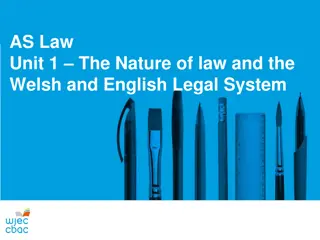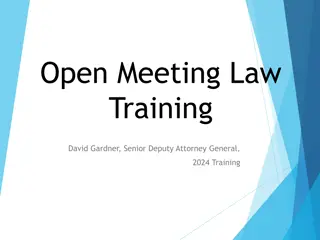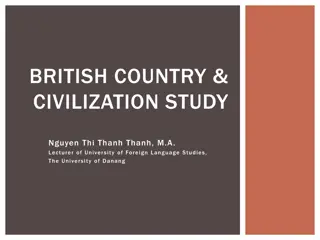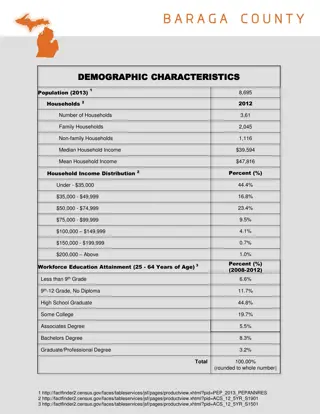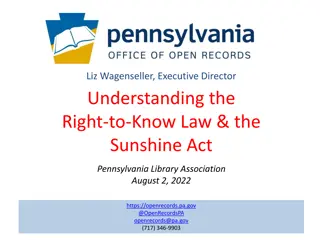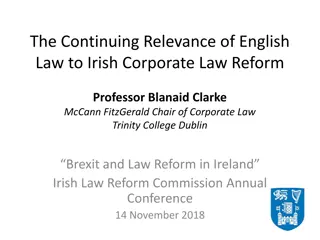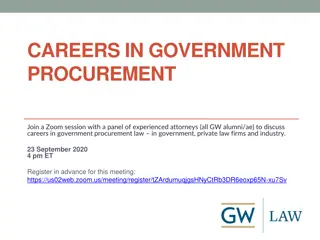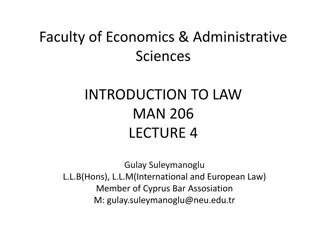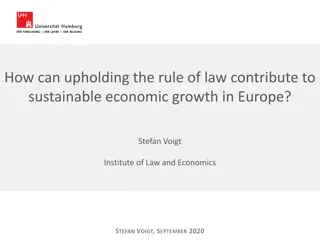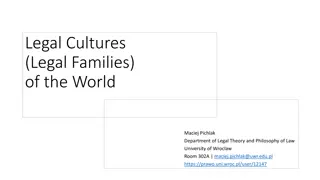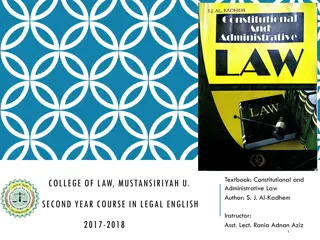
Evolution of Legal Systems in Pre-British Malaysia
Explore the historical legal systems in pre-British Malaysia, including the Hukum Kanun Melaka from the 15th century and other significant laws in Malay states. Learn about the Federal Constitution's role as the highest legal authority and its special features, such as protection for Malays and Bumiputera.
Download Presentation

Please find below an Image/Link to download the presentation.
The content on the website is provided AS IS for your information and personal use only. It may not be sold, licensed, or shared on other websites without obtaining consent from the author. If you encounter any issues during the download, it is possible that the publisher has removed the file from their server.
You are allowed to download the files provided on this website for personal or commercial use, subject to the condition that they are used lawfully. All files are the property of their respective owners.
The content on the website is provided AS IS for your information and personal use only. It may not be sold, licensed, or shared on other websites without obtaining consent from the author.
E N D
Presentation Transcript
LAW & GOVERNMENT
Discussion Before the coming of British, what was the legal system implemented in Malaysia (Malay states)? What is Hukum Kanun Melaka (15thcentury)? This law was written during the period of Sultan Muzaffar Syah (1446-1456) Do you know about Hukum Kanun Pahang 1596 (during the reign of Sultan Abdul Ghafur Muhaiyuddin Syah dari 1592 hingga 1614), Undang-undang Kedah 1667, Hukum Kanun Brunei, Undang-undang 99 Perak, Kanun Dato Setar Kedah 1784, Kanun Kelantan 1168H, Undang-undang Terengganu 1708 dan Undang-undang Johor 1789?
Chapter 2: Law & Government The Federal Constitution Fundamental Rights Federal System Branches of Government Legislature Administration of the government Public Service
Chapter 2: Law & Government The Federal Constitution
Federal Constitution Federal Constitution is said to be the highest legal authority of land. The Constitution was drafted by the Reid Commission in 1956 with 5 representatives from India, British, Pakistan and Australia. The Constitution came into force following the independence on August 31, 1957. It consists of 15 Parts, 183 Articles and 13 Schedules. Article 4(1) state that the constitution is the supreme law of the federation and any law passed after Merdeka Day which is inconsistent with this constitution shall, to the maximum extent of inconsistency, be void.
Special Features of the FC Monarchy: YDPA, Conference of Rulers, Rulers etc. Special protection for Malays and Bumiputera. Reservation of quotas in respect of services, permits, etc., for Malays and natives of any of the States of Sabah and Sarawak (Article 153) Malay reservation (Article 89) Malay means a person who professes the religion of Islam, habitually speaks the Malay language, conforms to Malay custom and (a) was before Merdeka Day born in the Federation or in Singapore or born of parents one of whom was born in the Federation or in Singapore, or is on that day domiciled in the Federation or in Singapore; or (b) is the issue of such a person; Islam as the religion of Federation (Article 3)
Important elements in the FC Fundamental Rights Constitutional monarchy Federalism (Federal system) Public service Separation of power (3 branches of government)
Chapter 2: Law & Government Fundamental Rights
Fundamental Rights WHAT are fundamental liberties? Fundamental liberties are rights and freedoms that we have as human beings. Some fundamental liberties are set out in the Constitution. Because these rights and freedoms are set out in the Constitution, they are said to be guaranteed and cannot be taken away from us unless the Constitution itself allows it.
Article 5 Right to life and personal liberty Every person has a right to life and liberty. A person s life or personal liberty cannot be taken away unless it is in accordance with law. The courts have said that the right to life includes a right to livelihood and quality of life, while the right to liberty includes the right to privacy. A person who is arrested or detained:- must be informed as soon as possible of the grounds of the arrest; has the right to consult and be defended by a lawyer of his/her choice (this is known as access to legal representation ); and must be brought before a magistrate within 24 hours and cannot be detained further unless it is with the authority of the magistrate, known as a remand order .
Fundamental Rights under the FC Article 6 No slavery or forced labour Article 7 Protection against retrospective criminal laws and repeated trials Article 8 Equality Article 9 Freedom of movement Article 10 Freedom of speech, assembly and association Article 11- Freedom of religion Article 12 - Rights in respect of education Article 13- Right to Property
Article 10: Freedom of speech, assembly and association (1) Subject to Clauses (2), (3) and (4) (a) every citizen has the right to freedom of speech and expression; (b) all citizens have the right to assemble peaceably and without arms; (c) all citizens have the right to form associations.
Article 11: Freedom of religion (1) Every person has the right to profess and practise his religion and, subject to Clause (4), to propagate it. (4) State law and in respect of the Federal Territories of Kuala Lumpur, Labuan and Putrajaya, federal law may control or restrict the propagation of any religious doctrine or belief among persons professing the religion of Islam.
13: Rights to property (1) No person shall be deprived of property save in accordance with law. (2) No law shall provide for the compulsory acquisition or use of property without adequate compensation.
Chapter 2: Law & Government Federal System
Federal System (Federalism) Federalism is a system based upon democratic rules and institutions in which the power to govern is shared between national and provincial/state governments, creating what is often called a federation. Federalism in Malaysia dates back to the establishment of the Federated Malay States in Peninsular Malaysia, then known as Malaya. Federalism in Malaysia took a more concrete form with the establishment of the Federation of Malaya. The state governments are led by chief ministers (Menteri Besar or Ketua Menteri, the latter term being used in states without hereditary rulers), selected by the state assemblies (Dewan Undangan Negeri) advising their respective sultans or governors.
Federal System (Federalism) Malaysian version of federalism gives the federal government not only the most legislative and executive powers but also the most important sources of revenue. State governments are excluded from the revenues of income tax, export, import and excise duties, and they are also largely restricted from borrowing internationally. State governments have to depend on revenue from forests, lands, mines, petroleum, the entertainment industry, and finally, transfer payments from the central government. Distribution of jurisdiction (9thSchedule of the Federal Constitution): Federal list: External affairs, defence of the federation, internal security, civil and criminal law and procedure and the administration of justice, federal citizenship, finance, trade, commerce and industry, communications and transport, surveys, inquiries and research, education, etc State list: Islamic law and personal and family law of persons professing the religion of Islam, Land tenure, agriculture and forestry, Local government
Chapter 2: Law & Government Branches of Government
Branches of government (Malaysia) Legislative (Parliament) Executive (Prime Minister and Cabinet members) Judiciary (Courts)
Chapter 2: Law & Government Legislature
Roles of the Parliament Parliament is the legislative authority for the Federation, and in this capacity, it makes laws applicable to the Federation as a whole. Parliament passes federal laws, makes amendments to existing federal laws. Parliament also may amend the Federal Constitution. Parliament also examines the government s policies. Parliament also approves the government s expenditures and approves new taxes. Parliament also serves as the forum for criticism and the focus of public opinion on national affairs.
Malaysian Legislature Legislative power is divided between federal and state legislatures. (States have Dewan Undangan Negeri (SLA)) The bicameral Parliament consists of: Yang Di-Pertuan Agoung Dewan Rakyat (the House of Representatives Dewan Negara (the Senate). Dewan Negara: All seventy members sit for three-year terms (to a maximum of two terms); twenty-six are elected by the thirteen state assemblies, and forty-four are appointed by the king based on the advice of the Prime Minister. Dewan Rakyat: The 222 members are elected from single-member districts in general elections
Malaysian Legislature Parliament has a maximum mandate of five years by law. The king may dissolve parliament at any time and usually does so upon the advice of the Prime Minister. General elections must be held within three months of the dissolution of parliament. In practice this has meant that elections have been held every three to five years at the discretion of the Prime Minister.
Chapter 2: Law & Government Administration of Government
Administration by the executive branch The Executive arm is the part of government that has sole authority and responsibility for the daily administration of the state. The executive branch executes the law. The executive officer is not supposed to make laws (the role of the legislature) or interpret them (the role of the judiciary). The role of the executive is to enforce the law as written by the legislature and interpreted by the judicial system. The Executive branch of the government formulates various socio-economic policies and development plans, for the development of the country as a whole. The Executive has the power and authority to generate revenues through the collection of various taxes, levies, fines, summons, custom duties, and fees, to name some, from the general public.
Executive power in Malaysia Executive power in Malaysia is vested in the cabinet led by the Prime Minister; Article 43 of the Federal Constitution stipulates that the prime minister must be a member of the Dewan Rakyat who, in the opinion of the Yang di-Pertuan Agong (YDPA), commands a majority in parliament. The cabinet is chosen from among members of both houses of Parliament and is responsible to that body.
Chapter 2: Law & Government Public Service
Public service The public service in Malaysia is pivotal around Article 132 of the Federal Constitution which stipulates that the public service shall consists of: the General Public Service of the Federation the State Public Services the Joint Public Services the Education Service the Judiciary and the Legal Service the Armed Forces
Other related institutions For all intents and purpose, Statutory Bodies and the Local Authorities are also considered as part of the Public Service. This is because both these autonomous bodies resemble the Public Service in many respects since they adopt the procedures of the Public Service pertaining to appointments, terms and conditions of service and the remuneration system. Besides that, their officers and staff also receive pension and other retirement benefits similar to the employees in the Public Service.
Government Agencies Public agencies are agencies in the Public Service at the Federal, State and the Local Government levels. Federal agencies consist of Ministries, Federal Departments and Federal Statutory Bodies. Each Ministry is headed by a Minister and the executive officer is known as the Secretary General. Typically there will be a number of departments and possibly one or more statutory bodies as well under a ministry. Head of departments are given the title Director General. State Agencies consist of state departments, state statutory bodies and local governments (City, Municipal and District Councils).





